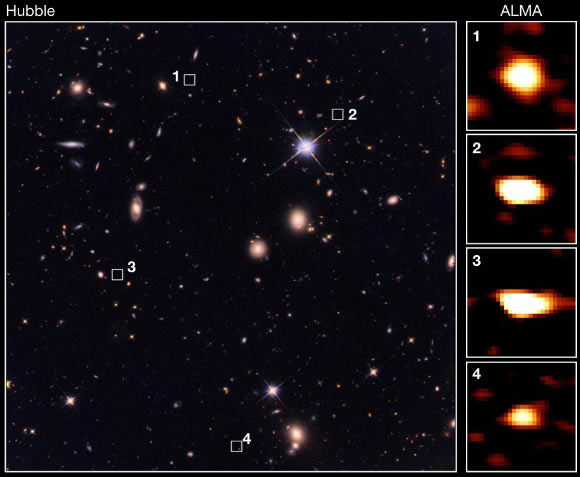Astronomers Spot Massive Star-Forming Galaxies in Early Universe | Astronomy – Sci-News.com
Using data from multiple space- and ground-based telescopes, an international team of astronomers has discovered 39 massive star-forming galaxies at a distance over 11.5 billion light-years away.

Massive and dusty star-forming galaxies are visible to ALMA (right), but invisible to Hubble (left). Image credit: Wang et al.
“This is the first time that such a large population of massive galaxies was confirmed during the first 2 billion years of the 13.7-billion-year life of the Universe. These galaxies were previously invisible to us,” said lead author Dr. Tao Wang, an astronomer in the Institute of Astronomy at the University of Tokyo.
“This finding contravenes current models for that period of cosmic evolution and will help to add some details, which have been missing until now.”
The newly-discovered population of galaxies is unseen in the spectral region from the deepest ultraviolet to the near-infrared.
“The light from these galaxies is very faint with long wavelengths invisible to our eyes and undetectable by Hubble,” explained Professor Kotaro Kohno, also from the University of Tokyo.
“So we turned to the Atacama Large Millimeter/submillimeter Array (ALMA), which is ideal for viewing these kinds of things.”
According to the astronomers, these star-forming galaxies are very different from our own.
“If our Solar System was inside one of them and you were to look up at the sky on a clear night, you would see something quite different to the familiar pattern of the Milky Way,” they said.
“For one thing, the night sky would appear far more majestic. The greater density of stars means there would be many more stars close by appearing larger and brighter,” Dr. Wang added.
“But conversely, the large amount of dust means farther-away stars would be far less visible, so the background to these bright close stars might be a vast dark void.”
The newly-discovered galaxies reside in massive dark matter haloes and are probably the progenitors of the largest present-day galaxies in massive groups and clusters.
“Such a high abundance of massive and dusty galaxies in the early Universe challenges our understanding of massive-galaxy formation,” the researchers concluded.
Their paper was published in the journal Nature.
_____
T. Wang et al. 2019. A dominant population of optically invisible massive galaxies in the early Universe. Nature 572: 211-214; doi: 10.1038/s41586-019-1452-4






